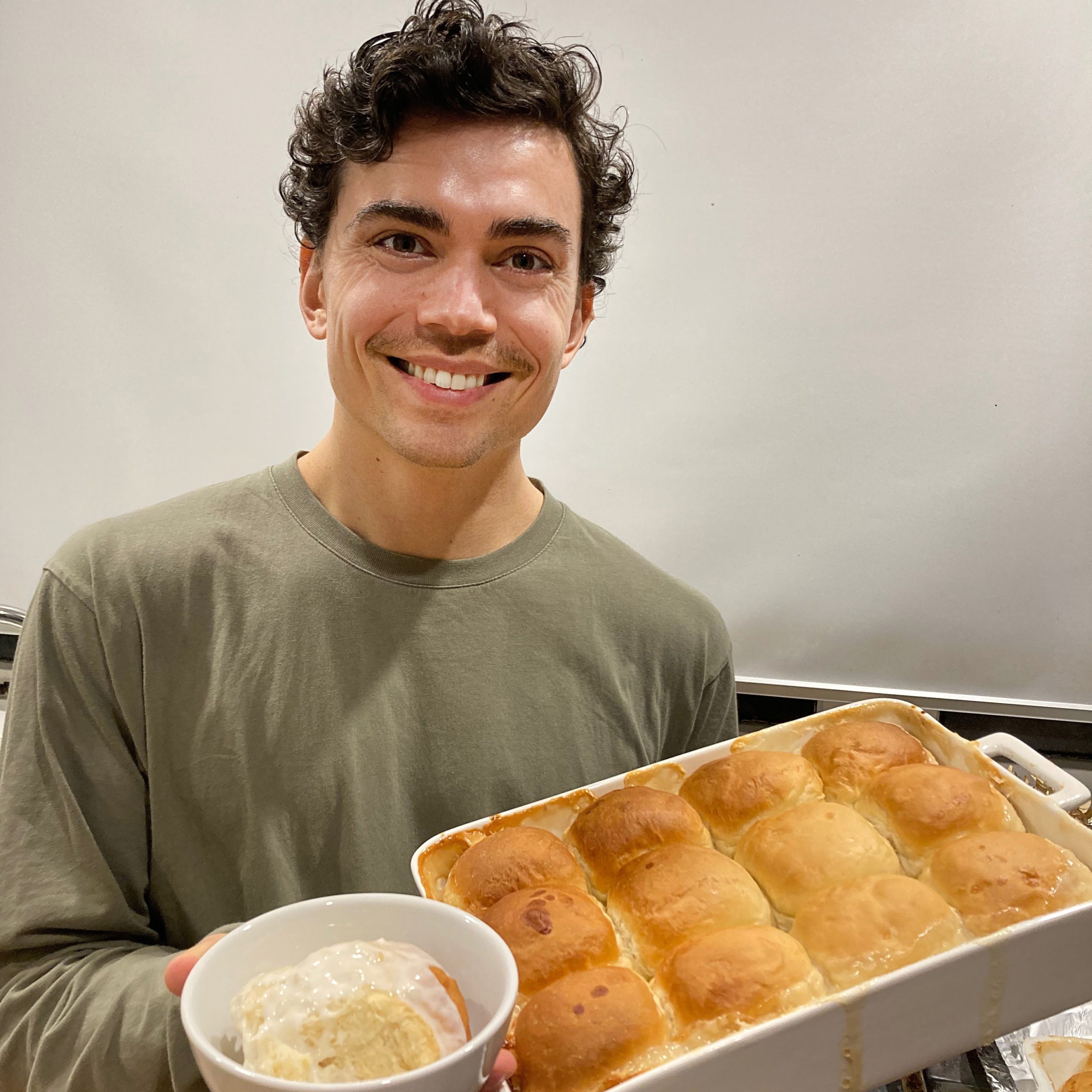Black Grace’s James Wasmer Shares His Pani Popo Recipe
James Wasmer’s life partner, who is of Samoan heritage, first introduced the Auckland, New Zealand–based dancer to pani popo. “Having been raised in a mixed-cultural family, I connected to it straightaway,” says Wasmer, who, with a German father and a Tongan mother, grew up between Germany and New Zealand. “Germans are known for their breads and pastries, and I have memories of drinking fresh coconut juice on Tonga and in the islands. So the dish was, for me, a bit of a marriage of those two worlds.” Now, Wasmer’s unique take on pani popo is a favorite at family gatherings.
Over time, Wasmer has adjusted the buns to be more like a yeasted brioche or challah than the Samoan original, and after he became vegan three years ago, he adapted them to be plant-based. “Being a dancer and someone who’s so physical, being vegan has required a bit more research,” says Wasmer, who has been vegetarian since he was 13 and has a certificate in vegan nutrition. For Wasmer, who is both a dancer and the company manager for Black Grace, cooking and baking serve as a chance to turn inward and reflect. “Kneading dough almost has a therapeutic component to it,” he says. “You get stuck in the repetition and can take that time to let your mind wander and process your day.”

Top-Secret Ingredient
When making savory dishes, Wasmer’s most-used secret ingredient is powdered vegetable stock. “It’s something I’ve learned from my mom,” he says. “It’s always the answer when we get asked for what exactly makes the dish taste so good—especially for vegetarian or vegan dishes.”
Other Pacific Island Favorites
Wasmer credits much of his interest in cooking to his Tongan heritage. “Food plays a very big part in Polynesian culture and Pacific Island culture,” he says. “Sharing food is a time when people come together and tell stories.” He particularly loves the islands’ surplus of beautiful, fresh produce. “There’s taro dishes and breadfruit dishes,” he says, adding that another of his favorites is palusami, or lu’au, a Samoan dish made of coconut and onions wrapped in a taro leaf parcel and cooked in an umu, or traditional hot stone oven. “It’s cooked aboveground in Samoa and underground in Tonga,” Wasmer adds.
Ingredients
Yeast Mixture
• 1 packet dry yeast (7 g)
• 120 ml (1/2 cup) lukewarm plant milk of your choice
• 2 tbsps sugar
Dough
• 500 g (4 cups) all-purpose flour, plus extra for kneading
• 50 g (1/4 cup) sugar
• 80 g (2.8 oz) softened vegan butter or margarine
• 160 ml (2/3 cup) plant-based milk
• 1 tsp salt
• 1 tsp vanilla extract
• small amount of neutral oil (canola or sunflower) to line the bowl
Sauce
• 1 13.5 oz/400 ml can coconut cream
• 60 ml (1/4 cup) plant milk
• 50 g (1/4 cup) sugar
Directions
- Activate the yeast by mixing milk, yeast and sugar in a small bowl. The milk should be between 105°F and 115°F—you can warm it in the microwave, but make sure it’s not too hot, as that can kill the yeast. Set the mixture aside for about 10 minutes, until it starts to foam.
- Place the flour, sugar, butter, milk, salt and vanilla in a large bowl. Mix in the yeast mixture and stir with a wooden spoon to combine.
- Transfer to a lightly floured work surface and knead for about 10 minutes by hand. If the dough sticks, add a bit more flour as needed. (This can be done in a stand mixer if preferred.)
- Lightly oil a large bowl, place the dough inside and cover with a damp tea towel. Let rise in a warm place for about one hour, or until doubled in size. (Wasmer usually places the dough in a hot-water cupboard—he also recommends a lightly preheated oven with the door open, or the sunniest spot in your home.)
- Once the dough has risen, knead it briefly for one to two minutes, then divide into 12 pieces. For uniformity, weigh the dough to ensure each piece is the same size. To shape into buns, cup your hand and roll the portioned dough against the counter. (If you want to get fancy and prefer buns to be in a scroll shape, flatten each portion into a long strip and roll up to create a spiral.)
- Place the buns in a deep nonstick baking dish, not quite touching each other to allow space for them to expand. Cover with the same tea towel and let rise again for about 20 minutes.
- Preheat oven to 355°F.
- Mix the sauce ingredients in a medium bowl and pour in between the risen buns.
- Bake for approximately 30 minutes, or until a skewer stuck into one of the buns comes out clean.
- To serve, scoop out a bun and drizzle with some (or lots) of the sauce from the bottom of the pan. They’re most delicious eaten warm.





